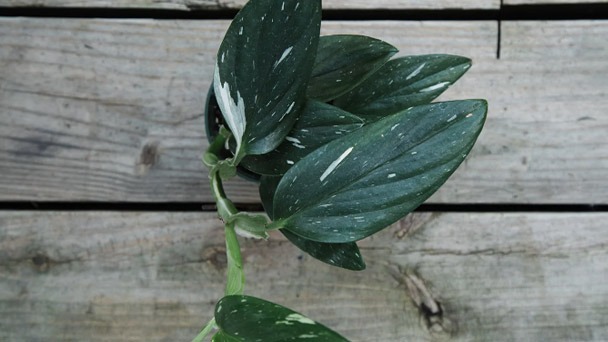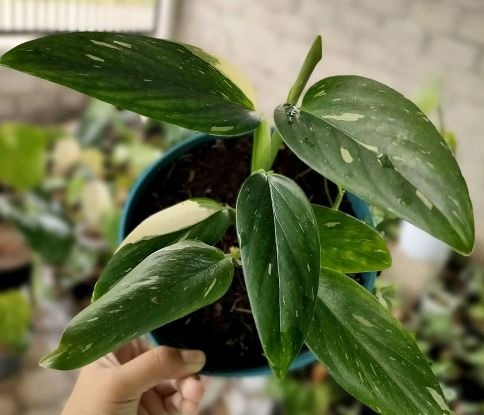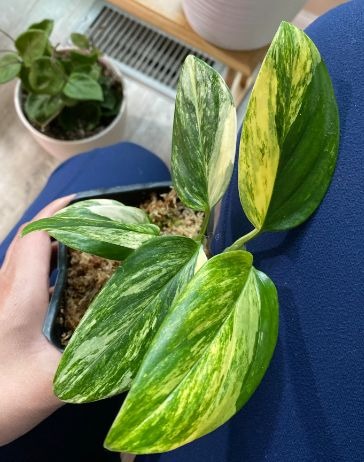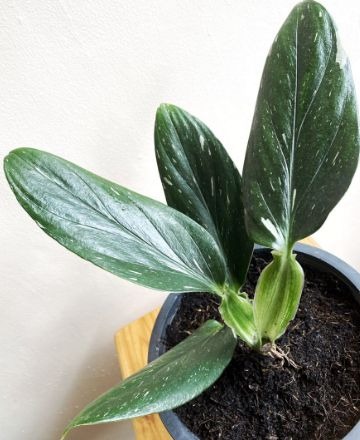Monstera Standleyana Albo - Growing & Propagation Guide
Written by Ivy
Jan 10 2023

Do you already have a variegated Monstera Standleyana in your botanical collection? If so, you are now interested in learning about Monstera Standleyana plant maintenance. Is it difficult to grow and requires more care? For answers to your inquiries, explore and read more below!
The entire subject of Monstera Standleyana will be covered in this article, from their identification to their upkeep and reproduction. In-depth discussion of Standleyana's distinctive variegation will also be covered. Let's start now, when you're ready.
What is Monstera Standleyana Albo?

Monstera Standleyana Albo variegata is a distinct variegated species of Standleyana with pronounced white bands or splashes across its leaves. All Standleyana are variegated, but this variety is more so than the common and freely available standard species.
Variegation is characteristic of the Standleyana, as was mentioned in the previous section, but these plants take on a completely different feel and become truly exquisite to view when entire regions of their leaves are white or cream.
Monstera Standleyana Albo Care Basics
If you are unfamiliar with plant care, it may be difficult to understand where to start. Once you master the fundamentals of plant care and develop a routine, however, you'll start to notice all the wonderful advantages of having plants as pets.
To help you care for your new plant kids, we've highlighted some top plant care techniques below for you:
Best Potting Mix
Soil that allows for reasonable water drainage is preferred by Monstera Standleyana. It drains neither too quickly nor too slowly. Too much water will cause the plant's roots to become waterlogged and develop "wet feet."
‘Wet feet always cause rot, which eventually kills your plant. Keep in mind that the plant needs oxygen for the roots as well. When the soil is too dense and poorly drained, there may not be enough oxygen reaching the roots.
A strong foundation is essential for the growth of Monstera Standleyana. You can mix your own aroid soil mix or buy it pre-blended from a garden center or nursery. This plant needs a soil mix that is well-draining. For aeration, perlite for moisture retention, and sphagnum moss for nutrients, three key ingredients are to be on the lookout for.
You can get a neutral pH reading by adding a little activated charcoal, as Monstera prefer a pH level of 5.5 to 7. Always choose a premium potting soil that is designed for indoor plants as the foundation for your Monstera.
Watering Needs
Make sure the soil is completely dry on the surface before watering the plant. Monstera Standleyana prefers to receive adequate and plentiful watering. If you forget to water it once, it won't be damaged as much if you overwater Monstera. Since this will lead to rot disease, never let the soil sit in water for an extended period of time.
The best strategy is to recognize when it is thirsty rather than following a set routine. In a typical indoor environment, watering should be done every 7 to 10 days, but this can change depending on the temperature.
Instead, wait until the top inch of soil on a Monstera Standleyana has completely dried out before watering it. Even though Monstera are tough, they can be susceptible to root rot, so it's best to err on the side of less frequent watering to avoid waterlogged soil.
Give your plant a good dose of water when you do hydrate it, but avoid letting water collect in the drip tray because this quickly turns into a bacterial nidus.
Ideal Lighting
How Monstera Standleyana leaves curl is a topic of many questions. This is a symptom of excessive light exposure, and the leaves are probably pleading for help. Put the pot somewhere that gets less sunlight. In a day or two, your plant will recover its health.
The Standleyana must be placed close to East or South-facing windows, set back a few feet to avoid direct exposure because Monstera love warmth and seek light. Although harsh afternoon sun is preferable to morning light, they should have at least six hours of access to bright, indirect light each day.
In the underbrush of rain and cloud forests, tropical epiphytes such as the Monstera Standleyana flourish. Monstera climb upwards toward the sun peeping through the canopy above them by attaching their aerial roots to the trunks of larger trees that are supporting them.
So, they are used to dappled light in their natural environment. Fortunately, as mentioned above, this is simple to replicate in a home setting, allowing you to meet your Monstera's light needs with careful placement.
Temperature
Because it originated in a warm climate, the plant prefers warmer temperatures. Attempt to maintain a temperature of at least 65°F (18°C). As a result, your plant's growth will either slow down or stop.
Fertilizer
If you fertilize it too much, the heavy salts that remain in the soil will cause your plant to dry out and possibly die. For your houseplants, find an organic fertilizer. It is advised that you fertilize it three times a year as doing so will hasten its growth.
Carefully fertilize it at least 15 cm away from the base of the plant. Additionally, never do it in the winter when most plants don't need food.
Monstera Standleyana can only benefit from being fed, though there are no strict guidelines. These lovely plants, like all indoor plants, benefit from a small nutrient boost, especially during the spring and summer when they grow quickly.
For your Monstera, you'll need a balanced, all-purpose liquid fertilizer with a slow release. To ensure there are no adverse effects, use a little bit less than recommended at first. Once it has adapted, though, adopt a feeding schedule of two to three doses annually. Your Monstera will remain extra content and healthy as a result, and you'll give it more energy so it can grow again.
Humidity
You should try to provide a Standleyana with as much humidity as you can in order to best replicate their natural habitat. These plants truly flourish in warm, humid environments. Unfortunately, most homes aren't naturally as humid as Monstera would like, but this can be easily remedied.
You can achieve the necessary humidity for your Monstera using any one of the methods listed below.
A plug-in humidifier is the first thing you might want to think about getting. Neither plants nor people will suffer from this. If you don't like that idea, consider placing your Monstera over a wet pebble tray, which will gradually evaporate moisture.
No issue if you're still not sure. Simply mist your Standleyana plants' leaves with a spray bottle once a week to treat them to extra moisture and keep them healthy and lush.
In cooler, less humid climates, monstera won't grow as quickly as usual, but it's not the end of the world either. They can endure a range of environments and temperatures and are well-adapted.
Growth Zone
In their natural habitat (a tropical and jungle canopy environment), Monstera Standleyana's runners or vines have a mind-boggling 20 foot maximum length. However, they can only grow to this size where they can grow vertically. A Monstera Standleyana can grow up to five feet tall indoors.
The leaves can grow to a maximum length of six to nine inches and a maximum width of about five inches. Give them enough room to grow, such as in your garden or in your backyard with foliage landscaping, if you want to see it at its full maturity.
Monstera Standleyana Potting
Indoor plants prefer free-moving roots in sizable pots. Check the bases of the pots every year. If the roots protrude from the drainage holes or pack in tightly, think about repotting to a larger container. Remember to take another look at the drainage!
To allow all of the extra water to drain, containers must have a sufficient number of drainage holes.
How Do You Propagate Standleyana?
A Monstera Standleyana must have its stems cut in order to be propagated. Do not propagate plants of this kind during the winter. It's possible to grow Monstera Standleyana in water as well. To give your plant an even more appealing appearance, submerge the stem. Cuttings from a healthy plant can root in 4 to 6 weeks under the right circumstances, making them ready to be planted and grown to maturity.
The fact that most Monstera are satisfying propagators is one trait they all share. If your cutting is healthy and has one or two nodes from which new growth can emerge, rooting a Monstera Standleyana is a straightforward procedure.
There are a few things to think about when choosing stems from your existing plant before I go into how to propagate Monstera cuttings. To stop the potential spread of diseases to your Monstera, use clean, well-kept, and sterilized tools at all times. Making sure your plant is healthy is the next step. Cutting off a section of a Monstera's stem won't help the plant's situation.
Last but not least, make sure your growing medium—soil or water—is prepared for when you make your cut. Plan ahead and set up your workstation so that you don't expose your cutting to air for any longer than is necessary.
Monstera should only be propagated in the spring and summer. These stunning animals enter a semi-dormant state in the winter and won't enjoy having to expend energy recovering from a cutting.
Propagating a Monstera Standleyana in Water
This is the simplest and most reliable method for growing a Monstera Standleyana stem cutting. Choose your cutting, make sure it has two to three healthy nodes and one to two leaves, and then place it in a jar with fresh water. The cut end of the stem can be dipped in growth hormone before use as an extra precaution.
Place the jar near a window that receives direct sunlight, and make sure to change the water once a week to maintain oxygen levels. In about four weeks, hopefully, you'll notice new growth. Transfer your cutting into a planter filled with soil when its roots are 1 to 2 inches (2.5 to 5 centimeters) long.
Propagating a Monstera Standleyana in Soil
A Monstera Standleyana can be grown in soil without first being rooted in water, though it is recommended. Place your cutting in your pot after filling it one-third of the way with high-quality Aroid soil mix and, if you have any on hand, after dipping it in rooting hormone. Stake the cutting if necessary to give it support.
Make sure your cutting has plenty of moisture and humidity when using this method. Without roots, Standleyana are unable to extract water from the soil, so they must obtain it from their surroundings. To keep your cutting damp and humid, you can either mist it every day or wrap it in plastic. Maintain your young plant close to bright, indirect light, just like with water propagation.
Growing Monstera Standleyana Seeds
Although more difficult than propagation, Monstera Standleyana can be grown from seed. Monstera seeds don't always guarantee germination and have a short shelf life.
Give your seeds 12 hours in lukewarm water to soak before planting to give them the best chance. Once in the ground, keep them as warm as you can. Within four to six weeks, they ought to begin to grow.
Spraying them with water and lightly covering them with a plastic cover or dome to trap humidity will help keep them moist once they have sprouted into saplings.

Monstera Standleyana Varieties and Similar Plants
In addition to being well-liked, monstera plants are also frequently easy to grow, making them a fantastic option for both novice and expert indoor gardeners.
Here is a list of some of the most well-known monstera varieties, along with some quick tips on how to grow them yourself.
Monstera Variegata
The common name for monstera plants with variegated leaves that have noticeable white splotches is Monstera Variegata. Similar to its non-variegated counterparts, Monstera Variegata is much more difficult to grow. Due to a combination of a low supply and a high demand, they have become relatively scarce.
Monstera Siltepecana
In both its juvenile and mature stages, Monstera Siltepecana, like other monstera plants, has two distinct shapes. Juvenile leaves are appealing due to their silvery color and deep-green venation.
Monstera Pinnatipartita
The South American rainforests are home to the endangered but highly sought-after Monstera Pinnatipartita species. One of the most fascinating aspects of care is watching a Monstera Pinnatipartita's leaves change as it ages.
The leaves of these outdoor plants don't start to split apart and get pinnation until they're fully grown.
Monstera Deliciosa (AKA Swiss Cheese Plant)
Throughout the tropical forests of southern Mexico and Panama, you can find the flowering Swiss cheese plant. Due to the holes in its leaves, it got its name. Because it produces such delicious fruit, this plant is also known as the Mexican Breadfruit Plant.
Monstera Dubia
Monstera Dubia, also referred to as the "shingle plant," is a climbing vine whose leaves rest flat against the tree or trellis it ascends. The monstera plant has pale and dark green variegation on its heart-shaped leaves. Despite being a monstera, the plant does not fenestrate its leaves until it is fully grown.
Is Monstera Standleyana a Fast Grower?
In ideal conditions, Monstera Standleyana grows quickly, particularly in the spring and summer. It is a smaller species of Monstera, but what it lacks in height it makes up for in spread, growing upwards in an alternate pattern that gives it a full, dense appearance.
The adage "a plant grows well in ideal conditions" may seem obvious, but for this particular species of Monstera, it couldn't be more true. A Standleyana can grow so quickly in conditions with lots of humidity, water, and light that it at least once a year needs to be repotted.
As a smaller species of Monstera, this lovely plant almost seems to compensate for its diminutive size with its lush, densely growing foliage. It also matures at a much faster rate than other Monstera's smaller leaves. It will be motivated to grow even more quickly if it has a good place to climb (for instance, if you give your Monstera a moss pole covered in nutrient-rich moss).
Don't become alarmed, however, if you notice that your Standleyana isn't growing as quickly as you'd like. It might imply that it isn't getting enough light or humidity. This doesn't imply that it's sick; rather, it just suggests that it might have to be relocated to a location that better suits its requirements.
Monstera Standleyana Diseases & Pests
A common and annoying bug that can infest your plant is the aphid. These pests will siphon off the sap and nutrients. In order to protect your plant, it would be best if you were constantly on the lookout for them. The earlier you get rid of them, the better.
Your Monstera Standleyana has sap all over it because aphids eat the nutrients in it. That sap is the leftover food that a bug leaves behind after eating, not the sap itself.
Why Are My Monstera Standleyana Leaves Curling?
Monstera Standleyana never curls, which is never a good sign. It typically denotes either a lack of water, fertilizer, or light, or an abundance of one of these factors. If you see Monstera curling, try as quickly as possible to determine the root of the issue so you can treat your plant appropriately.
When plants are in distress, you may notice wilting, yellowing, curling, browning, or other leaf changes on your Monstera. It usually has to do with water problems, either under- or overwatering your Monstera, which, regrettably, has the same negative effects. Use your fingertip to test the soil to find the cause. Your plant might be experiencing the early stages of root rot if it is heavy and soggy. Your Standleyana's leaves may be curling if the air is very dry because of dehydration.
If water is not the issue, your Monstera Standleyana may be experiencing stress due to a lack of nutrients in its soil, which can be resolved with repotting or fertilization. On the other hand, it could be overfertilized, which would result in chemical burn and, by extension, yellowing and curling. (Read More: Why Does My Monstera Have Yellow Leaves)
Although the over- or under-exposure to sunlight would need to be extremely severe for this to occur, Monstera Standleyana's poor health may also be related to an extreme lack of light. Long periods of direct sunlight may cause the leaves to begin to curl, giving your Monstera a sunburn.
Check your Monstera Standleyana for pests or other disease symptoms if none of the aforementioned symptoms seem to be the problem. Intense pest infestations, though less frequent, can cause Monstera leaf curl and drop, and they need to be dealt with right away.
Does Monstera Standleyana Have Fenestrations?
The Monstera Standleyana is an exception to the rule in the family of Monstera plants, which typically develop fenestrations as they grow older. Some claim that while it might fenestrate in its natural environment, apertures won't appear in domestic settings.
The large jungle leaves that are featured in art prints and home décor all over the world and can be identified by their distinctive fenestrations are typically what come to mind when we think of Monstera. Of course, one of the reasons Monstera is so simple to identify as a species is because almost all of their species have windowed leaves.
This is where the Monstera Standleyana differs slightly from other plants because it never seems to develop any holes, no matter how big it gets. This could be the reason it's frequently mistaken for a Philodendron or simply not recognized as a Monstera.
The next time you're searching for a distinctive Monstera, consider this beauty's variegation. Although the leaves of this Monstera may never split, you will still be rewarded by their undeniable beauty and, as with all Monstera, by how simple they are to care for.
Can a Monstera Standleyana Live in Water?
Monstera Standleyana can survive and root in water for a few weeks or months, but once their root systems have grown significantly, it is ideal to move them into a planter with soil. Standleyana needs soil for survival because it has rich nutrients and minerals that water alone lacks.
When you can observe a Monstera Standleyana's root development through glass and water, it is particularly lovely. However, this is only really suitable for your plant while it is establishing roots because once it begins to grow seriously, it will require additional food from the soil.
However, this does not imply that your Monstera Standleyana will perish if submerged in water. With regular water replacements, it could possibly last for months or even years. It is more likely to experience disease or distress and is less likely to thrive. They also have a tendency to grow more slowly in water.
Is the Monstera Standleyana Toxic?
Depending on how much is consumed, the sticky sap found in Monstera's leaves and stems can be mildly poisonous to both humans and animals. This means that all Monstera are toxic to varying degrees. Ingestion can result in gastrointestinal distress or breathing difficulties, while skin contact can cause rashes and irritation.
The good news is that Monstera Standleyana is hardly appetizing and is therefore unlikely to be a preferred snack for either children or pets. Naturally, mishaps and curiosity do occur, so if you believe a person or animal has consumed or come into contact with Standleyana sap, give them medical attention right away.
It's likely that this plant will only cause minor harm, such as a little stomach discomfort, nausea, or skin irritation, but it's always best to err on the side of caution and get professional advice. Despite being extremely rare, extreme reactions can cause pulmonary distress.
But remember, prevention is always better than cure, so keep your prized Standleyana out of the reach of kids and pets. Use gloves when handling this plant, and try to avoid breaking its stems or leaves.

How Much is a Monstera Standleyana Albo?
Depending on size, variety, and breeder, a Monstera Standleyana Albo can sell for anywhere between $50 and $180. These plants are relatively uncommon, don't appear on the market very frequently, and as a result, prices can differ greatly from vendor to vendor.
Price setting for Monstera Standleyana Albo is not an art; it ultimately depends on supply and demand, as well as size and appearance. The price will increase as a Standleyana's variegation becomes more distinct. In fact, when you see some variegated Monstera prices, be prepared for some sticker shock.
On the other hand, there is no assurance that a Monstera Standleyana cutting will take root with its new owner, so it might sell for less than $100. On the other hand, if it is a large, healthy specimen, the cost of a full-grown variegated Monstera Standleyana may skyrocket.
Conclusion
In order to properly care for Monstera Standleyana, it is important to provide it with enough moisture, light, nutrients, good soil, and humidity. Although the Standleyana requires simple maintenance, it can benefit from fertilizing occasionally. However, with the right care and shelter, standleyana can be grown outdoors as well.
Frequently Asked Questions
Are All Monstera Standleyana Variegated?
All Monstera Standleyana are variegated and, to varying degrees, have spots or dashes of white, cream, or yellow on their leaves and stems. Standleyana's leaves have a base color of dark green, which contrasts beautifully with this unusual presentation.
Usually, there are white flecks on the Standleyana plant's leaves. However, some variegated varieties have a different level of variegation than the original plant. The structure and other traits of the parent plant are shared by every variety of Variegated Monstera standleyana. The Standleyan Monstera Variegated Yellow is an illustration of this. It offers a distinctive and lovely yellow or cream variegation. The variegation is comprised of sporadic yellow spots, streaks, and even clearly visible variegated leaf sections.
Is Monstera Standleyana Rare?
One of the most peculiar-looking climbers among the rare exotic Aroids is the Monstera Standleyana. Because the blooms grow on a type of inflorescence known as a spadix, these monocotyledonous flowering plants have a distinctive way of blooming.
Why Are My Monstera Standleyana Leaves Curling?
The leaves on your Monstera Standleyana are curled as a result of excessive light exposure, as was already mentioned. The leaves may cry out for help as a result. Place the pot in a less sunny area. Within a day or two, the health of your plant will return.
Latest Updated
- Benefits of Bugleweed - 7 Science-backed Health Benefits
- Bugleweed Dangers & Side Effects - Is It Poisonous?
- How to Plant Evergreen Trees - What You Should Know
- When to Plant Evergreens - Grow Guide for Evergreen Trees
- 12 Wonderful Evergreen Shrubs for Your Garden
- 12 Popular Evergreen Plants with Pictures for Beginners
- When And How To Prune A Lilac Bush Like a Pro
- How to Grow & Care for Lilac Vine (Hardenbergia Violacea)
- Japanese Lilac Tree (Syringa Reticulata) Care & Propagation Guide
- Shumard Oak Pros and Cons - What to Know
Popular Articles
- Winter maintenance of Antirrhinum Majus
- How to Grow Terminalia Mantaly Tree
- How to Grow and Care for Crossostephium Chinense
- How to grow Antirrhinum Majus in spring
- Peristeria Elata (Dove Orchid) Profile: Info & Care Guide
- Underwatered Snake Plant (Sansevieria Trifasciata) - Signs And How To Fix
- How to Care for Brazilian Jasmine Plant (Mandevilla Sanderi)
- How to Grow & Care for Graptopetalum Purple Delight in Summer
- Rosa Chinensis (China Rose): Plant Growing & Care Tips
- How to Care for Baby Sun Rose (Aptenia Cordifolia)